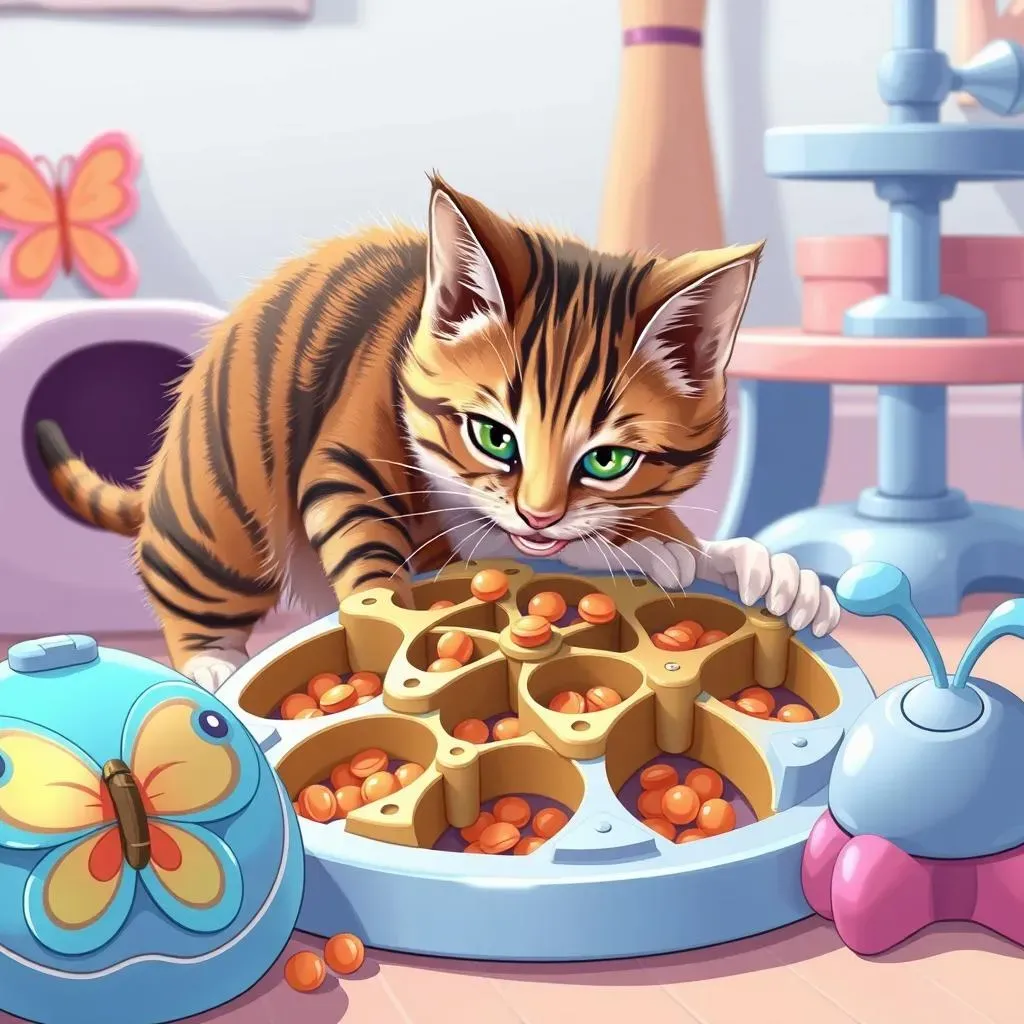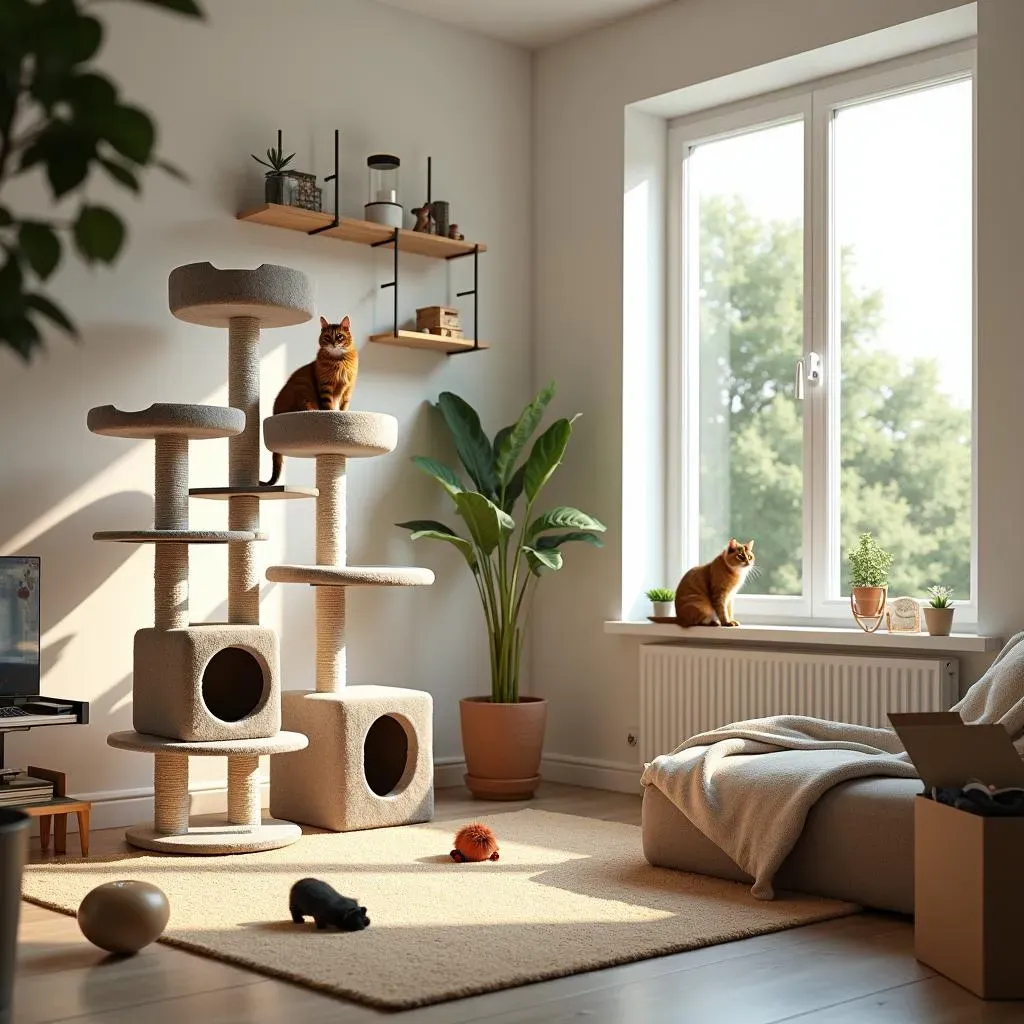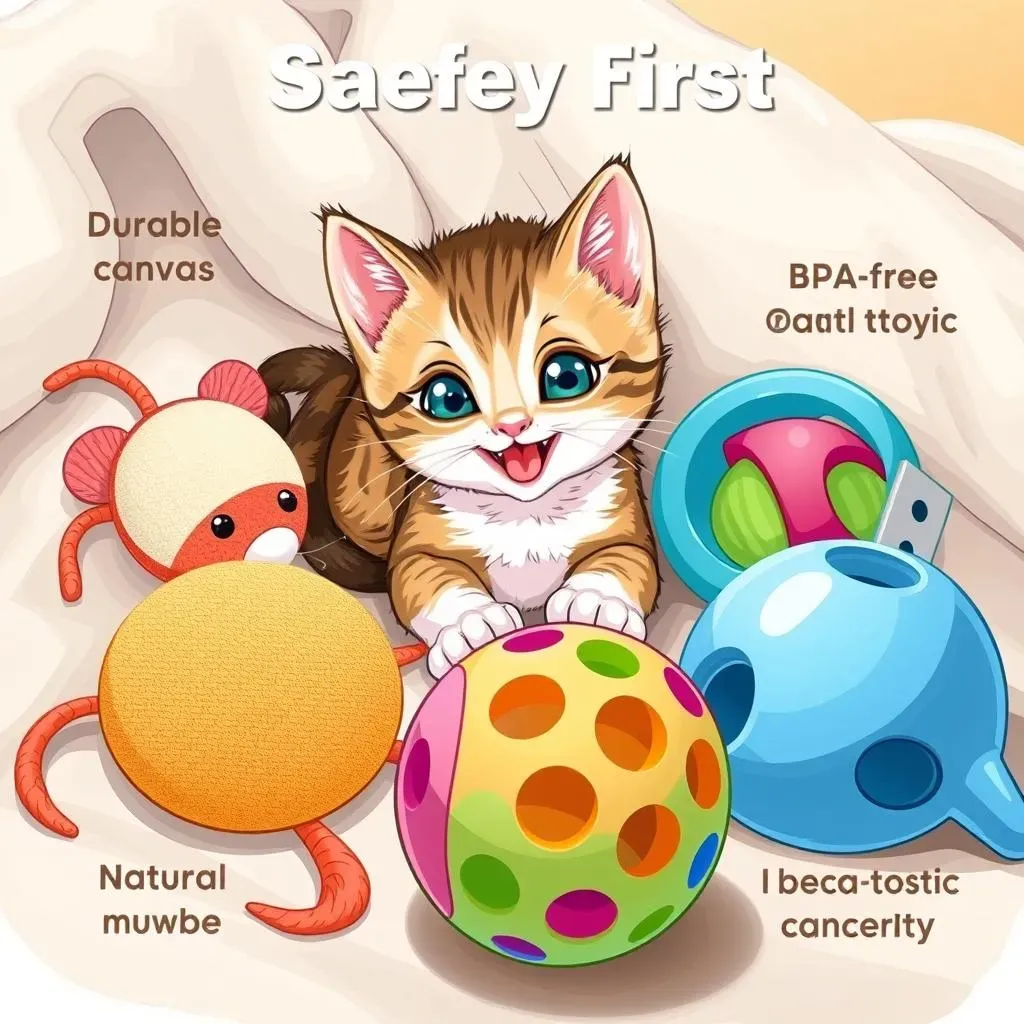Table of Contents
Leaving your cat home alone doesn't have to mean a day of feline boredom. Cats are naturally curious and playful creatures, and providing them with the right toys can keep them entertained and stimulated while you're away. But with so many options available, how do you choose the best cat toys for solo play? This article will guide you through understanding your cat's individual play style, explore a variety of top-rated toys perfect for independent play, and offer tips on creating an engaging environment that encourages activity. We'll also cover essential safety considerations to ensure your furry friend stays safe while having fun. From interactive puzzles to motorized toys and self-grooming stations, discover how to transform your home into a stimulating playground for your solo kitty, promoting their physical and mental well-being until you return.
Understanding Your Cat's Solo Play Needs

Understanding Your Cat's Solo Play Needs
Decoding Your Cat's Play Style
Ever wonder why your cat ignores that fancy toy you bought but goes crazy for a crumpled piece of paper? Understanding your cat's individual play style is key to choosing the right toys. Some cats are hunters, drawn to toys that mimic prey, like feather wands or toy mice. Others are climbers and explorers, preferring toys they can bat around and chase. Observing your cat's behavior during playtime will give you valuable insights into their preferences. Do they stalk and pounce? Are they more interested in batting and chasing? Knowing their style will help you curate a selection of toys they'll actually enjoy.
Consider their age, too. Kittens have different play needs than senior cats. Kittens are bundles of energy, needing toys that encourage active play and development of their motor skills. Older cats might prefer gentler, less strenuous options. Pay attention to what gets your cat excited and engaged, and tailor your toy choices accordingly.
The Importance of Environmental Enrichment
Think of your home as your cat's territory. A stimulating environment is crucial for their well-being, especially when they're home alone. Environmental enrichment goes beyond just providing toys; it's about creating a space that caters to their natural instincts. This includes providing scratching posts to satisfy their urge to scratch, perches or cat trees for climbing and observation, and hiding places where they can feel safe and secure.
Toys are an essential part of this enrichment. Rotate your cat's toys regularly to keep them interested. Cats can get bored easily, so introducing new toys or simply rearranging the ones they already have can reignite their curiosity. Think of it like giving them a fresh set of options to explore and conquer. Don't underestimate the power of simple things like cardboard boxes or paper bags – cats often find endless entertainment in these everyday items.
Recognizing Signs of Boredom and Stress
Even with the best toys and a stimulating environment, cats can still experience boredom or stress when left alone for extended periods. It's important to recognize the signs so you can take steps to address them. Common signs of boredom include excessive sleeping, overeating, and destructive behavior like scratching furniture or knocking things over. Stress can manifest as changes in appetite, litter box issues, or increased vocalization.
If you notice any of these signs, consider adding more interactive elements to your cat's environment. Puzzle toys that dispense treats can provide mental stimulation and keep them engaged. Consider a window perch so they can watch the outside world. You might even consider getting a second cat, but only if you are prepared for the responsibility of another animal. Most importantly, make sure to dedicate quality playtime with your cat when you are home to strengthen your bond and provide the social interaction they crave.
TopRated Cat Toys for Independent Play: Reviews & Recommendations

TopRated Cat Toys for Independent Play: Reviews & Recommendations
Interactive Puzzle Toys
let's dive into some of the top-rated cat toys for independent play! First up are interactive puzzle toys. These are like brain games for your cat, challenging them to figure out how to get to a hidden treat. Think of it as a feline version of a Rubik's Cube, but with a delicious reward. These toys not only keep your cat entertained but also provide mental stimulation, preventing boredom and anxiety. There are a ton of different puzzle toys out there, from simple treat dispensers to more complex mazes that require your cat to use their paws and nose to solve the puzzle.
One of the most popular types of interactive puzzle toys is the treat ball. You fill it with your cat's favorite treats, and they have to roll it around to get the treats to fall out. It's a great way to keep them active and engaged. Another option is a puzzle feeder, which requires your cat to solve a series of challenges to access their food. This can slow down fast eaters and provide a fun and stimulating way for them to get their meals. I think a simple one is always a good choice, because it can be difficult for cats to learn a complex puzzle
Motion Activated Toys and Self-Groomers
Next on the list are motion-activated toys. These toys use sensors to detect your cat's movement and then spring to life, mimicking the movements of prey. Think fluttering butterflies, scurrying mice, or even just a laser pointer that dances across the floor. These toys can be a great way to engage your cat's hunting instincts and provide them with a fun and unpredictable play experience. However, it's important to choose motion-activated toys that are safe and durable. Avoid toys with small parts that could be swallowed, and make sure the toy is made from materials that are non-toxic and resistant to chewing.
Don't forget about self-grooming stations! These are toys that allow your cat to groom themselves while also providing a source of entertainment. They typically consist of a brush or textured surface that your cat can rub against to remove loose fur. Some self-grooming stations also include catnip to entice your cat to use them. These toys can be especially beneficial for cats who shed a lot or who are prone to hairballs. They can help to reduce shedding, prevent hairballs, and keep your cat's coat healthy and shiny. Plus, they provide a source of comfort and relaxation for your furry friend.
Creating the Purrfect Play Environment for Solo Cats

Creating the Purrfect Play Environment for Solo Cats
Vertical Space: Think Cat Trees and Shelves
When creating the purrfect play environment for solo cats, don't just think about floor space – think vertical! Cats love to climb and observe their surroundings from a high vantage point. Cat trees are a fantastic way to provide this, offering multiple levels for climbing, scratching, and lounging. Look for cat trees with different textures and features to keep your cat interested. Some have sisal scratching posts, while others have plush platforms or dangling toys. Shelves are another great way to create vertical space. Install shelves at varying heights along a wall to create a cat-friendly climbing route. Make sure the shelves are sturdy and can support your cat's weight. You can even add carpet or padding to the shelves to make them more comfortable.
Consider placing a cat tree or shelf near a window. Cats love to watch the outside world, and providing them with a perch near a window will give them hours of entertainment. Just make sure the window is safe and secure, and that your cat can't escape. You might even consider adding a bird feeder outside the window to attract even more attention. Remember, vertical space is all about providing your cat with opportunities to explore, climb, and observe, which can help to reduce boredom and stress when they're home alone.
Here's a quick checklist to boost your cat's vertical playground:
- Sturdy Cat Tree: Multiple levels, scratching posts, and comfy spots.
- Wall Shelves: Create a climbing route with secure shelving.
- Window Perch: A safe spot for birdwatching and sunbathing.
Rotating Toys and Creating Hidden Treasures
Cats get bored easily, so keeping their play environment fresh and exciting is key. One of the best ways to do this is to rotate their toys regularly. Instead of leaving all of their toys out all the time, put some away and then bring them out again a few days or weeks later. This will make the toys seem new and exciting again. You can also try hiding toys around the house for your cat to discover. This will engage their hunting instincts and provide them with a fun and stimulating activity. Think of it as an Easter egg hunt, but for cats!
Another fun idea is to create a "treasure hunt" for your cat. Hide treats or small toys in different locations around the house and then let your cat loose to find them. This will keep them active and engaged, and it's a great way to provide mental stimulation. You can also use puzzle toys for this purpose, filling them with treats and then hiding them around the house. Just make sure to choose hiding spots that are safe and accessible for your cat. Avoid hiding toys in places where they could get stuck or injured. With a little creativity, you can transform your home into a stimulating and engaging playground for your solo cat.
Toy Rotation Schedule | Week 1 | Week 2 | Week 3 |
|---|---|---|---|
Toys Available | Feather wand, treat ball, catnip mouse | Laser pointer, puzzle feeder, crinkle ball | Cat tree, tunnel, self-grooming station |
Safety First: Choosing the Right Toys for Unsupervised Play

Safety First: Choosing the Right Toys for Unsupervised Play
Prioritizing Safe Materials and Construction
let's talk safety because, honestly, that's the most important thing when choosing toys your cat will play with alone. You've got to think about what could go wrong. Are there small parts that could be swallowed? Is the toy made of materials that could be toxic if ingested? Choosing the right toys for unsupervised play is all about minimizing those risks. Look for toys made from durable, non-toxic materials like natural rubber, heavy-duty canvas, or BPA-free plastic. Avoid toys with small parts that could be easily detached and swallowed, such as buttons, beads, or ribbons. Check the construction of the toy to make sure it's sturdy and well-made. Seams should be securely stitched, and there shouldn't be any loose threads or sharp edges. You really don't want your cat ending up at the vet because of a poorly made toy.
I think it's always a good idea to supervise your cat's playtime with a new toy for the first few times, just to see how they interact with it and whether they're likely to try to chew off any pieces. Also, regularly inspect your cat's toys for wear and tear. If you notice any damage, like cracks, tears, or loose parts, discard the toy immediately. It's better to be safe than sorry when it comes to your cat's health.
Material | Safety | Considerations |
|---|---|---|
Natural Rubber | Generally safe | Check for latex allergies |
Heavy-Duty Canvas | Durable, non-toxic | Inspect seams regularly |
BPA-Free Plastic | Safe if BPA-free | Avoid if chewed aggressively |
Avoiding Potential Hazards: Strings, Small Parts, and Batteries
Beyond materials, there are specific hazards to watch out for. Strings and ribbons might seem like fun for cats to bat around, but they can be incredibly dangerous if ingested. Cats can swallow these items, leading to intestinal blockages that require surgery to remove. So, avoid toys with long strings, ribbons, or elastic bands. If you do choose to give your cat a toy with a string, make sure it's short and securely attached.
Small parts are another big concern. As mentioned earlier, cats can easily swallow small items like buttons, beads, or plastic eyes. These can cause choking or intestinal blockages. Choose toys that are larger than your cat's mouth and that don't have any detachable small parts. Battery-operated toys can be fun, but they also pose a risk. Cats can chew on the battery compartment and ingest batteries, which can cause serious chemical burns. If you do choose a battery-operated toy, make sure the battery compartment is securely sealed and that your cat can't access the batteries. It's also a good idea to supervise your cat's playtime with battery-operated toys to make sure they don't try to chew on them.
Size and Durability: Matching Toys to Your Cat's Play Style
Finally, think about your cat's individual play style when choosing toys. Some cats are gentle players, while others are more aggressive. If your cat is a rough player, you'll need to choose toys that are durable enough to withstand their abuse. Look for toys made from tough materials like reinforced nylon or heavy-duty rubber. Avoid toys that are easily torn apart or that have weak seams. Size is also an important consideration. Choose toys that are appropriately sized for your cat. Small toys can be a choking hazard, while large toys may be too difficult for your cat to play with.
I have a friend whose cat is a total toy destroyer. She has to buy special, super-durable toys just to keep them from being shredded in minutes. It's all about knowing your cat and what they're capable of! By taking the time to choose safe, durable, and appropriately sized toys, you can help to ensure that your cat has a fun and safe playtime experience, even when you're not around.
Conclusion: Happy Cats, Happy Homes with the Best Toys for Solo Play
Investing in the best cat toys for solo play isn't just about keeping your cat busy; it's about enriching their lives and ensuring their well-being. By understanding your cat's preferences, creating a stimulating environment, and prioritizing safety, you can transform their alone time into a fun and fulfilling experience. Remember to rotate toys regularly, engage in interactive play when you're home, and always supervise your cat with new toys. A happy, entertained cat makes for a happy home, and with the right selection of solo play toys, you can provide your feline friend with the stimulation they need to thrive, even when you're not around.